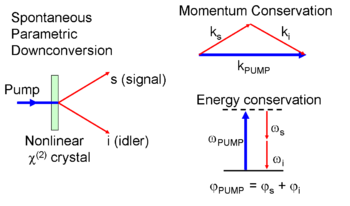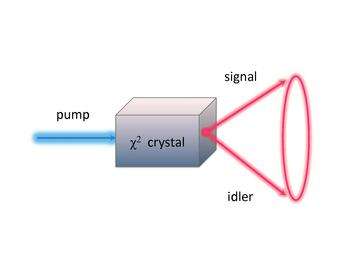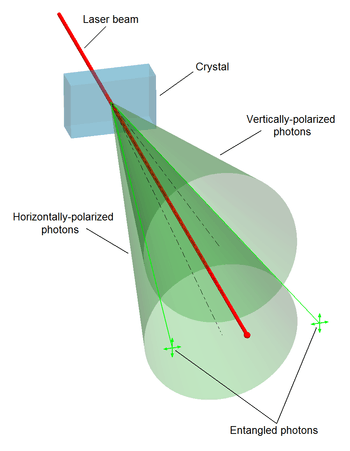Spontaneous parametric down-conversion
Spontaneous parametric down-conversion (also known as SPDC, parametric fluorescence or parametric scattering) is a nonlinear instant optical process that converts one photon of higher energy (namely, a pump photon), into a pair of photons (namely, a signal photon, and an idler photon) of lower energy, in accordance with the law of conservation of energy and law of conservation of momentum. It is an important process in quantum optics, for the generation of entangled photon pairs, and of single photons.

Basic process

A nonlinear crystal is used to split photon beams into pairs of photons that, in accordance with the law of conservation of energy and law of conservation of momentum, have combined energies and momenta equal to the energy and momentum of the original photon and crystal lattice. Because the index of refraction changes with frequency, only certain triplets of frequencies will be phase-matched so that simultaneous energy and momentum conservation can be achieved. Phase-matching is most commonly achieved using birefringent nonlinear materials, whose index of refraction changes with polarization. As a result of this, different types of SPDC are categorized by the polarizations of the input photon (the pump) and the two output photons (signal and idler). If the signal and idler photons share the same polarization with each other and with the destroyed pump photon it is deemed Type-0 SPDC[1]; if the signal and idler photons share the same polarization to each other, but are orthogonal to the pump polarization, it is Type-I SPDC. If the signal and idler photons have perpendicular polarizations, it is deemed Type II SPDC[2]
The conversion efficiency of SPDC is typically very low, with the highest efficiency obtained on the order of 4 pairs per 106 incoming photons for PPLN in waveguides.[3] However, if one half of the pair (the "signal") is detected at any time then its partner (the "idler") is known to be present. The degenerate portion of the output of a Type I down converter is a squeezed vacuum that contains only even photon number terms. The degenerate output of the Type II down converter is a two-mode squeezed vacuum.
Example

In a commonly used SPDC apparatus design, a strong laser beam, termed the "pump" beam, is directed at a BBO (beta-barium borate) or Lithium niobate crystal. Most of the photons continue straight through the crystal. However, occasionally, some of the photons undergo spontaneous down-conversion with Type II polarization correlation, and the resultant correlated photon pairs have trajectories that are constrained along the edges of two cones, whose axes are symmetrically arranged relative to the pump beam. Also, due to the conservation of momentum, the two photons are always symmetrically located along the edges of the cones, relative to the pump beam. Importantly, the trajectories of the photon pairs may exist simultaneously in the two lines where the cones intersect. This results in entanglement of the photon pairs whose polarizations are perpendicular.[4][5]:205
Another crystal is KDP (potassium dihydrogen phosphate) which is mostly used in Type I down conversion, where both photons have the same polarization.[6]
History
SPDC was described as early as 1970 by David Klyshko and coauthors,[7] and D. C. Burnham and D. L. Weinberg.[8][9] It was first applied to experiments related to coherence by two independent pairs of researchers in the late 1980s: Carroll Alley and Yanhua Shih, and Rupamanjari Ghosh and Leonard Mandel.[10][11] The duality between incoherent (Van Cittert–Zernike theorem) and biphoton emissions was found.[12]
Applications
SPDC allows for the creation of optical fields containing (to a good approximation) a single photon. As of 2005, this is the predominant mechanism for an experimenter to create single photons (also known as Fock states).[13] The single photons as well as the photon pairs are often used in quantum information experiments and applications like quantum cryptography and Bell test experiments.
SPDC is widely used to create pairs of entangled photons with a high degree of spatial correlation.[14] Such pairs are used in ghost imaging, in which information is combined from two light detectors: a conventional, multi-pixel detector that doesn't view the object, and a single-pixel (bucket) detector that does view the object.
Alternatives
The newly observed effect of two-photon emission from electrically driven semiconductors has been proposed as a basis for more efficient sources of entangled photon pairs.[15] Other than SPDC-generated photon pairs, the photons of a semiconductor-emitted pair usually are not identical but have different energies.[16] Until recently, within the constraints of quantum uncertainty, the pair of emitted photons were assumed to be co-located: they are born from the same location. However, a new nonlocalized mechanism for the production of correlated photon pairs in SPDC has highlighted that occasionally the individual photons that constitute the pair can be emitted from spatially separated points.[17][18]
See also
References
- Lerch, Stefan; Bessire, Bänz; Bernhard, Christof; Feurer, Thomas; Stefanov, André (2013-04-01). "Tuning curve of type-0 spontaneous parametric down-conversion". Journal of the Optical Society of America B. 30 (4): 953–958. arXiv:1404.1192. Bibcode:2013JOSAB..30..953L. doi:10.1364/JOSAB.30.000953. ISSN 0740-3224.
- Boyd, Robert (2008). Nonlinear Optics, Third Edition. New York: Academic Press. pp. 79–88. ISBN 978-0-12-369470-6.
- Bock, Matthias; Lenhard, Andreas; Chunnilall, Christopher; Becher, Christoph (17 October 2016). "Highly efficient heralded single-photon source for telecom wavelengths based on a PPLN waveguide". Optics Express. 24 (21): 23992–24001. Bibcode:2016OExpr..2423992B. doi:10.1364/OE.24.023992. ISSN 1094-4087. PMID 27828232.
- P. Kwiat; et al. (1995). "New High-Intensity Source of Polarization-Entangled Photon Pairs". Phys. Rev. Lett. 75 (24): 4337–4341. Bibcode:1995PhRvL..75.4337K. doi:10.1103/PhysRevLett.75.4337. PMID 10059884.
- Anton Zeilinger (12 October 2010). "The super-source and closing the communication loophole". Dance of the Photons: From Einstein to Quantum Teleportation. Farrar, Straus and Giroux. ISBN 978-1-4299-6379-4.
- Reck, M H A, Quantum Interferometry with Multiports: Entangled Photons in Optical Fibers (page 115) (PDF), retrieved 16 February 2014
- Klyshko D. N., Penin A. N., Polkovnikov B. F., "Parametric Luminescence and Light Scattering by Polaritons", JETP Lett. 11, 05 (1970)
- Burnham, D. C.; Weinberg, D. L. (1970). "Observation of simultaneity in parametric production of optical photon pairs". Phys. Rev. Lett. 25 (2): 84. Bibcode:1970PhRvL..25...84B. doi:10.1103/physrevlett.25.84.
- D. Greenberger, M. Horne, and A. Zeilinger, "A Bell Theorem Without Inequalities for Two Particles, Using Efficient Detectors" (2005), note 18.
- Y. Shih and C. Alley, in Proceedings of the 2nd Int'l Symposium on Foundations of QM in Light of New Technology, Namiki et al., eds., Physical Society of Japan, Tokyo, 1986.
- Ghosh, R.; Mandel, L. (1987). "Observation of Nonclassical Effects in the Interference of Two Photons". Phys. Rev. Lett. 59 (17): 1903–1905. Bibcode:1987PhRvL..59.1903G. doi:10.1103/physrevlett.59.1903. PMID 10035364.
- http://pra.aps.org/abstract/PRA/v62/i4/e043816 - Duality between partial coherence and partial entanglement
- Zavatta, Alessandro; Viciani, Silvia; Bellini, Marco (2004). "Tomographic reconstruction of the single-photon Fock state by high-frequency homodyne detection". Physical Review A. 70 (5): 053821. arXiv:quant-ph/0406090. Bibcode:2004PhRvA..70e3821Z. doi:10.1103/PhysRevA.70.053821.
- Walborn, S.P.; Monken, C.H.; Pádua, S.; Souto Ribeiro, P.H. (2010). "Spatial correlations in parametric down-conversion". Physics Reports. 495 (4–5): 87–139. arXiv:1010.1236. Bibcode:2010PhR...495...87W. doi:10.1016/j.physrep.2010.06.003. ISSN 0370-1573.
- A. Hayat, P. Ginzburg, M. Orenstein, Observation of Two-Photon Emission from Semiconductors, Nature Photon. 2, 238 (2008)
- Chluba, J.; Sunyaev, R. A. (2006). "Induced two-photon decay of the 2s level and the rate of cosmological hydrogen recombination". Astronomy and Astrophysics. 446 (1): 39–42. arXiv:astro-ph/0508144. Bibcode:2006A&A...446...39C. doi:10.1051/0004-6361:20053988.
- Forbes, Kayn A.; Ford, Jack S.; Andrews, David L. (2017-03-30). "Nonlocalized Generation of Correlated Photon Pairs in Degenerate Down-Conversion" (PDF). Physical Review Letters. 118 (13): 133602. Bibcode:2017PhRvL.118m3602F. doi:10.1103/PhysRevLett.118.133602. PMID 28409956.
- Forbes, Kayn A.; Ford, Jack S.; Jones, Garth A.; Andrews, David L. (2017-08-23). "Quantum delocalization in photon-pair generation" (PDF). Physical Review A. 96 (2): 023850. Bibcode:2017PhRvA..96b3850F. doi:10.1103/PhysRevA.96.023850.